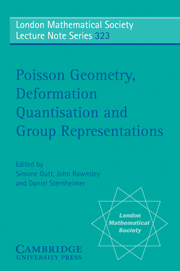Book contents
- Frontmatter
- Contents
- Preface
- Part One Poisson geometry and morita equivalence
- Part Two Formality and star products
- Part Three Lie groupoids, sheaves and cohomology
- 1 Introduction
- 2 Lie groupoids
- 3 Sheaves on Lie groupoids
- 4 Sheaf cohomology
- 5 Compactly supported cohomology
- Bibliography
- Part Four Geometric methods in representation theory
- Part Five Deformation theory: a powerful tool in physics modelling
- Index
2 - Lie groupoids
Published online by Cambridge University Press: 04 August 2010
- Frontmatter
- Contents
- Preface
- Part One Poisson geometry and morita equivalence
- Part Two Formality and star products
- Part Three Lie groupoids, sheaves and cohomology
- 1 Introduction
- 2 Lie groupoids
- 3 Sheaves on Lie groupoids
- 4 Sheaf cohomology
- 5 Compactly supported cohomology
- Bibliography
- Part Four Geometric methods in representation theory
- Part Five Deformation theory: a powerful tool in physics modelling
- Index
Summary
In this chapter we give a short introduction to the theory of Lie groupoids. We also recall some of the most important constructions and examples, such as the holonomy groupoid of a foliation [26, 61]. Groupoids were first mentioned in the work of Brandt from the beginning of the twentieth century. Haefliger [23] already used étale Lie groupoids and pseudogroups to describe the transversal structure of foliations, and later Lie groupoids turned out to be one of the most adequate geometric models for non-commutative geometry (Connes [12]).
This chapter closely follows our presentation at the Euroschool, and much of it is taken directly from [48] where the reader can find more details. Sections 2.5 and 2.6 on the category of generalized morphisms and principal bundles were originally written (several years ago) as part of [48], but not included in the final version.
In our presentation, we have emphasized the notion of weak equivalence between Lie groupoids. A Lie groupoid may be viewed as a formal quotient of a manifold, such as the formal space of leaves of a foliation, where all the information can be lost if one takes the usual topological quotient. Weak equivalence is the equivalence relation between Lie groupoids, which, intuitively speaking, identifies Lie groupoids which represent the same quotient. For example, for an action of a discrete group on a manifold, a representation of the ‘space of orbits’ which is more refined than the topological orbit space is provided by the action groupoid of the action, as well as by any groupoid weakly equivalent to this action groupoid.
- Type
- Chapter
- Information
- Publisher: Cambridge University PressPrint publication year: 2005



